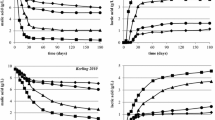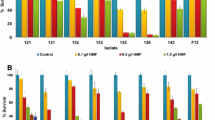Abstract
Nitrogen starvation may lead to stuck and sluggish fermentations. These undesirable situations result in wines with high residual sugar, longer vinification times, and risks of microbial contamination. The typical oenological method to prevent these problems is the early addition of ammonium salts to the grape juice, although excessive levels of these compounds may lead to negative consequences for the final product. This addition reduces the overall fermentation time, regardless of the time of addition, but the effect is more significant when nitrogen is added during the yeast exponential phase. In this work we analysed the effect of adding different nitrogen sources (ammonia, amino acids or a combination of both) under nitrogen depletion in order to understand yeast metabolic changes that lead to the adaptation to the new conditions. These studies were carried out in a synthetic must that mimics the composition of the natural must. Furthermore, we studied how this addition affects fermentative behaviour, the levels of several yeast volatile compounds in the final product, arginase activity, and the expression of several genes involved in stress response and nitrogen metabolism during vinification. We found that the nature of the nitrogen source added during yeast late exponential growth phase introduces changes to the volatile compounds profile and to the gene expression. On the other hand, arginase activity and the expression of the stress response gene ACA1 are useful to monitor nitrogen depletion/addition during growth of the wine yeast considered under our vinification conditions.



Similar content being viewed by others
References
Amorós M, Estruch F (2001) Hsf1p and Msn2/4p cooperate in the expression of Saccharomyces cerevisiae genes HSP26 and HSP104 in a gene- and stress-type-dependent manner. Mol Microbiol 39:1523–1532
Avendaño A, DeLuna A, Olivera H, Valenzuela L, González A (1997) GDH3 encodes a glutamate dehydrogenase isozyme, a previously unrecognized route for glutamate biosynthesis in Saccharomyces cerevisiae. J Bacteriol 179:5594–5597
Äyrapää T (1968) Formation of higher alcohols by various yeasts. J Inst Brew 74:169–179
Backhus LE, DeRisi J, Brown PO, Bisson LF (2001) Functional genomic analysis of a commercial wine strain of Saccharomyces cerevisiae under differing nitrogen conditions. FEMS Yeast Res 1413:1–15
Beltran G, Novo M, Rozès N, Mas A, Guillamón JM (2004) Nitrogen catabolite repression in Saccharomyces cerevisiae during wine fermentations. FEMS Yeast Res 4:625–632
Beltran G, Esteve-Zarzoso B, Rozès N, Mas A, Guillamón JM (2005) Influence of the timing of nitrogen additions during synthetic grape must fermentations on fermentation kinetics and nitrogen consumption. J Agric Food Chem 53:996–1002
Bely M, Sablayrolles JM, Barre P (1990) Description of alcoholic fermentation kinetics:its variability and significance. Am J Enol Vitic 41:319–324
Bisson LF (1991) Influence of nitrogen on yeast and fermentation of grapes. In: Ranz JM (ed) Proceedings of the international symposium on nitrogen in grapes and wine. American Society of Enology and Viticology, Davis, CA
Bisson LF (1999) Stuck and Sluggish Fermentations. Am J Enol Vitic 50:107–119
Boer VM, de Winde JH, Pronk JT, Piper MDW (2003) The genomic-wide transcriptional responses of Saccharomyces cerevisiae grown on glucose in aerobic chemostat cultures limited for carbon, nitrogen, phosphorus, or sulphur. J Biol Chem 278:3265–3274
Boulton RB, Singleton VL, Bisson LF, Kunkee RE (1996) Principles and practices of winemaking. In: Boulton RB (ed) Chapman & Hall, New York
Cantarelli C (1957) On the activation of alcoholic fermentation in winemaking. Am J Enol Vitic 8:113–120, 167–175
Carrasco P, Pérez-Ortín JE, del Olmo M (2003) Arginase activity is a useful marker of nitrogen limitation during alcoholic fermentations. System Appl Microbiol 26:471–479
Chi Z, Arneborg N (1999) Relationship between lipid composition, frequency of ethanol-induced respiratory deficient mutants and ethanol tolerance in Saccharomyces cerevisiae. J Appl Microbiol 86:1429–1440
Cornell NW, Veech RL (1983) Enzymatic measurement of ethanol or NAD in acid extracts of biological samples. Anal Biochem 132:418–423
Dammann R, Lucchini R, Koller T, Sogo JM (1993) Chromatin structures and transcription of rDNA in yeast Saccharomyces cerevisiae. Nucleic Acids Res 21:2331–2338
DeLuna A, Avendaño A, Riego L, González A (2001) NADP-glutamate dehydrogenase isoenzymes of Saccharomyces cerevisiae. Purification, kinetic properties and physiological roles. J Biol Chem 47:43775–43783
Fernández de Simón B, Cadahía E, Galocha J (2003) Volatile compounds in a spanish red wine aged in barrels made of Spanish, French and American oak. Word J Agric Food Chem 51:7671–7678
Fleet GH, Heard GM (1993). Yeasts-Growth during fermentation. In: Fleet GH (ed) Wine microbiology and biotechnology. Harwood Academic Publishers, Chur, Switzerland, pp 27–57
Forsburg SL, Guarente L (1989) Communication between mitochondria and the nucleus in regulation of cytochrome genes in the yeast Saccharomyces cerevisiae. Annu Rev Cell Biol 5:153–180
Fukuda K, Yamamoto N, Kiyokawa Y, Yanagiuchi T, Wakai Y, Kitamoto K, Inoue Y, Kimura A (1998) Balance of activities of alcohol acetyltransferase and esterase in Saccharomyces cerevisiae is important for production of isoamyl acetate. Appl Microbiol Biotechnol 64:4076–4078
Garcia-Gimeno MA, Struhl K (2000) Aca1 and Aca2, ATF/CREB activators in Saccharomyces cerevisiae, are important for carbon source utilization but not the response to stress. Mol Cell Biol 20:4340–4349
Gasch AP, Spellman PT, Kao CM, Carmel-Harel O, Eisen MB, Storz G, Botstein D, Brown PO (2000) Genomic expression programs in the response of yeast cells to environmental changes. Mol Biol Cell 11:4241–4257
Henick-Kling T, Edinger W, Daniel P, Monk P (1998) Selective effects of sulfhur dioxide and yeast starter culture addition on indigenous yeast populations and sensory characteristics of wine. J Appl Microbiol 84:865–876
Hernández-Orte P, Cacho JF, Ferreira V (2002) Relationship between varietal amino acid profile of grapes and wine aromatic composition. Experiments with model solutions and chemometric study. J Agric Food Chem 50:2891–2899
Hernández-Orte P, Ibarz M.J, Cacho J, Ferreira V (2005) Effect of the addition of ammonium and amino acids to musts of Airen variety on aromatic composition and sensory properties of the obtained wine. Food Chem 89:163–174
Herraiz T, Ough CS (1993) Formation of ethyl esters of amino acids by yeasts during the alcoholic fermentation of grape juice. Am J Enol Vitic 44:41–48
Horie T, Isono K (2001) Cooperative functions of the mannoprotein-encoding genes in the biogenesis and maintenance of the cell wall in Saccharomyces cerevisiae. Yeast 18:1493–503
Ingledew WM, Kunkee RE (1985). Factors influencing sluggish fermentations of grape juice. Am J Enol Vitic 36:65–76
Jiranek V, Langridge P, Henschke PA (1991) Yeast nitrogen demand: selection criterion for wine yeasts for fermenting low nitrogen musts. In: Ranz JM (ed) Proceedings of the international symposium on nitrogen in grapes and wine. American Society of Enology and Viticology, Davis, CA
Kolkman A, Daran-Lapujade P, Fullaondo A, Olsthoorn MM, Pronk JT, Slijper M, Heck AJ (2006) Proteome analysis of yeast response to various nutrient limitations. Mol Syst Biol 2:2006.0026
Lambrechts M, Pretorius IS (2000) Yeast and its importance to wine aroma. S Afr J Enol Vitic 21:97–129
Lilly M, Bauer FF, Styger G, Lambrechts MG, Pretorius IS (2006) The effect of increased branched-amino acid transaminase activity in yeast on the production of higher alcohols and on the flavour properties of wine and distillates. FEMS Yeast Res 6:726–743
Llauradó JM, Rozés N, Constantí M, Mas A (2005). Study of Saccharomyces cerevisiae strains for winemaking alter preadaptation at low temperatures. J Agric Food Chem 53:1003–1011
Marks VD, van der Merwe GK, van Vuuren HJJ (2003) Transcriptional profiling of wine yeast in fermenting grape juice: regulatory effect of diammonium phosphate. FEMS Yeast Res 3:269–287
Magasanik B (1992) Regulation of nitrogen utilization. In: Jones EW, Pringle JR, Broach JR (ed.), The molecular and cellular biology of the yeast Saccharomyces. Volume II: gene expression. Cold Spring Harbor Laboratory Press, New York
Mendes-Ferreira A, Mendes-Faia A, Leao C (2004) Growth and fermentation patterns of Saccharomyces cerevisiae under different ammonium concentrations and its implications in winemaking industry. J Appl Microbiol 97:540–545
Messenguy F, Dubois E (1983) Participation of transcriptional and post-transcriptional regulatory mechanisms in the control of arginine metabolism in yeast. Mol Gen Genet 189:148–156
Monteiro F, Bisson LF (1992) Nitrogen supplementation of grape juice. I. Effect on amino acid utilization during fermentation. Am J Enol Vitic 43:1–10
Monteiro F, Trousdale EK, Bisson LF (1989). Ethyl carbamate formation in wine: use of radioactively labeled precursors to demonstrate the involvement of urea. Am J Enol Vitic 40:1–8
Ough CS, Crowell EA, Mooney LA (1988) Formation of ethyl carbamate precursors during grape juice (Chardonnay) fermentation. I. Addition of amino acids, urea, and amonia: effects of fortification on intracellular and extracellular precursors. Am J Enol Vitic 39:243–249
Pierce JS (1987) Horace Brown Memorial lecture: the role of nitrogen in brewing. J Inst Brew 93:378–381
Puig S, Pérez-Ortín J.E (2000) Expression levels and patterns of glycolytic genes during wine fermentation. Syst Appl Microbiol 23:300–303
Rapp A, Versini G (1991) Influence of nitrogen compounds in grapes on aroma compounds of wines. In: Ranz JM (ed) Proceedings of the international symposium on nitrogen in grapes and wine. American Society of Enology and Viticology. Davis, CA
Riou C, Nicaud JM, Barre P, Gaillardin C (1997) Stationary-phase gene expression in Saccharomyces cerevisiae during wine fermentation. Yeast 13:903–915
Rossignol T, Dulau L, Julien A, Blondin B (2003) Genome-wide monitoring of wine yeast expression during alcoholic fermentation. Yeast 20:1369–1385
Salmon JM, Barre P (1998) Improvement of nitrogen assimilation and fermentation kinetics under enological conditions by derepression of alternative nitrogen-assimilatory pathways in an industrial Saccharomyces cerevisiae strain. Appl Environ Microbiol 64:3831–3837
Sumrada R, Cooper TG (1978). Control of vacuole permeability and protein degradation by the cell cycle arrest signal in Saccharomyces cerevisiae. J Bacteriol 136:234–246
Tai SL, Boer VM, Daran-Lapujade P, Walsh MC, De Winde JH, Daran JM, Pronk JT (2005) Two dimensional transcriptome analysis in chemostat cultures. Combinatorial effects of oxygen availability and macronutrient limitation in Saccharomyces cerevisiae. J Biol Chem 280:437–447
Varela C, Pizarro F, Agosin E (2004) Biomass content governs fermentation rate in nitrogen-deficient wine musts. Appl Env Microbiol 70:3392–3400
Varela C, Cárdenas J, Melo F, Agosin E (2005) Quantitative analysis of wine yeast gene expression profiles under winemaking conditions. Yeast 22:369–383
Verstrepen KJ, Derdelinckx G, Dufour JP, Winderickx J, Thevelein JM, Pretorius I.S., Delvaux F.R (2003) Flavor-active esters: adding fruitness to beer. J Biosci. Bioeng 96:110–118
Whitney PA, Magasanik B (1973) The induction of arginase in Saccharomyces cerevisiae. J Biol Chem 248:6197–6202
Wiame JM, Grenson M, Arst HNJR (1985) Nitrogen catabolite repression in yeasts and filamentous fungi. Adv Microb Physiol 26:1–88
Wu J, Zhang N, Hayes A, Panoutsopoulou K, Oliver SG (2004) Global analysis of nutrient control of gene expression in Saccharomyces cerevisiae during growth and starvation. PNAS 101:3148–3153
Yin Z, Stead D, Selway L, Walker J, Riba-Garcia I, Mclnerney T, Gaskell S, Oliver SG, Cash P, Brown AJP (2004) Proteomic response to amino acid starvation in Candida albicans and Saccharomyces cerevisiae. Proteomics 4:2425–2436
Zuzuarregui A, del Olmo M (2004a) Analyses of stress resistance under laboratory conditions constitute a suitable criterion for wine yeast selection. Antonie van Leewenhoek 85:271–280
Zuzuarregui A, del Olmo M (2004b) Expression of stress response genes in wine strains with different fermentative behavior. FEMS Yeast Res. 4:699–710
Zuzuarregui A, Monteoliva L, Gil C, del Olmo M (2006) Transcriptomic and proteomic approach for understanding the molecular basis of adaptation of Saccharomyces cerevisiae to wine fermentation. Appl Environ Microbiol 72:836–847
Acknowledgements
We thank Dr. Emilia Matallana for helpful discussions during the development of this study and Dr. J. E. Pérez-Ortín for critical reading of the manuscript. This work has been supported by grants AGL2002-01109 from the “Ministerio de Ciencia y Tecnología” and AGL2005-00508 from the “Ministerio de Educación y Ciencia” and GRUPOS03/012 from the “Generalitat Valenciana”. Agustín Aranda is a “Ramón y Cajal” researcher. Elena Jiménez-Martí is a Spanish F.P.I. fellow.
Author information
Authors and Affiliations
Corresponding author
Rights and permissions
About this article
Cite this article
Jiménez-Martí, E., Aranda, A., Mendes-Ferreira, A. et al. The nature of the nitrogen source added to nitrogen depleted vinifications conducted by a Saccharomyces cerevisiae strain in synthetic must affects gene expression and the levels of several volatile compounds. Antonie van Leeuwenhoek 92, 61–75 (2007). https://doi.org/10.1007/s10482-006-9135-1
Received:
Accepted:
Published:
Issue Date:
DOI: https://doi.org/10.1007/s10482-006-9135-1




